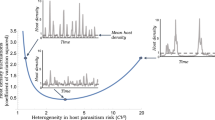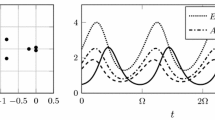Abstract.
In this paper we develop a general mathematical model describing the spatio-temporal dynamics of host-parasitoid systems with forced generational synchronisation, for example seasonally induced diapause. The model itself may be described as an individual-based stochastic model with the individual movement rules derived from an underlying continuum PDE model. This approach permits direct comparison between the discrete model and the continuum model. The model includes both within-generation and between-generation mechanisms for population regulation and focuses on the interactions between immobile juvenile hosts, adult hosts and adult parasitoids in a two-dimensional domain. These interactions are mediated, as they are in many such host-parasitoid systems, by the presence of a volatile semio-chemical (kairomone) emitted by the hosts or the hosts’ food plant. The model investigates the effects on population dynamics for different host versus parasitoid movement strategies as well as the transient dynamics leading to steady states. Despite some agreement between the individual and continuum models for certain motility parameter ranges, the model dynamics diverge when host and parasitoid motilities are unequal. The individual-based model maintains spatially heterogeneous oscillatory dynamics when the continuum model predicts a homogeneous steady state. We discuss the implications of these results for mechanistic models of phenotype evolution.
Similar content being viewed by others
References
Ambriz, S.J., Strand, M.R., Burkholder, W.E.: Behavioral response of the parasitoid Lariophagus distinguendus (frost) (hymenoptera: Pteromalidae) to extracts from cocoons of Lasioderma serricorne fab. (coleoptera anobiidae) and their effects on subsequent oviposition responses. Biol. Control, 6, 51–56 (1996)
Anderson, A.R.A.: The Role of Structure in Mediating Chemical Gradients and Nematode Movement: Theory and simulation. PhD thesis, University of Dundee, 1996
Anderson, A.R.A., Chaplain, M.A.J.: Continuous and discrete mathematical models of tumor-induced angiogenesis. Bull. Math. Biol., 60, 857–899 (1998)
Anderson, A.R.A., Chaplain, M.A.J., Newman, E.L., Steele, R.J.C., Thompson, A.M.: Mathematical modelling of tumour invasion and metastasis. J. Theor. Med., 2, 129–154 (2000)
Anderson, A.R.A., Sleeman, B.D., Young, I.M., Griffiths, B.S.: Nematode movement along a chemical gradient in a structural heterogeneous environment. 2. theory. Fundam. Appl. Nematol., 20 (2), 165–172 (1997)
Boerlijst, M.C.: Spirals and spots: Novel evolutionary phenomena through spatial self-structuring. In: U. Dieckmann, R. Law, J.A.J. Metz, (eds.) The Geometry of Ecological Interactions: Simplifying Complexity, pages 171–182. Cambridge University Press, Cambridge, 2000
Cardé, R.T., Bell, W.J.: Chemical Ecology of Insects 2. Chapman Hall, New York, N.Y., 1995
S. Colazza, G. Salerno, and E. Wajnberg. Volatile and contact chemicals released by Nezara viridula (hepteroptera:pentatomidae) have a kairomonal effect on the egg parasitoid Trissolcus basalis (hymenoptera:scelionidae). Biol. Control, 16:310–317, 1999.
Comins, H.N., Hassell, M.P., May, R.M.: The spatial dynamics of host-parasitoid systems. J. Anim. Ecol., 61, 735–748 (1992)
Cronhjort, M.B.: The interplay between reaction and diffusion. In: U. Dieckmann, R. Law,J.A.J. Metz, (eds.)The Geometry of Ecological Interactions: Simplifying Complexity, pages 151–171. Cambridge University Press, Cambridge, 2000
Doutt, R.L.: The biology of parasitic hymenoptera. Annu. Rev. of Entomo., 1959
Driessen, G., Bernstein, C., van Alphen, J.J.M., Kacelnik, A.: A count-down mechanism for host search in the parasitoid Venturia canescens. J. Anim. Ecol., 64, 117–125 (1995)
Dunbar, S.R.: Travelling wave solutions of diffusive lotka-volterra equations. J. Math. Biol., 17, 11–32 (1983)
Durrett, R., Levin, S.A.: The importance of being discrete (and spatial). Theor. Popul. Biol, 46, 363–394 (1994)
Godfray, H.C.J.: Parasitoids: Behavioural and Evolutionary Ecology. Princeton University Press, Princeton, N.J., 1994
Grindrod, P.: Patterns and Waves. Clarendon Press, Oxford, 1991
Hassell, M.P.: The dynamics of arthropod predator-prey associations. Princeton University Press, Princeton, N.J., 1978
Hassell, M.P.: The Spatial and Temporal Dynamics of Host-Parasitoid Interactions. Oxford University Press, Oxford, 2000
Hassell, M.P., May, R.M.: Aggregation of predators and insect parasites and its effect on stability. J. Anim. Ecol., 43, 567–594 (1974)
Hassell, M.P., Pacala, S.W.: Heterogeneity of host-parasitoid interactions. Philos. Trans. R. Soc. Lond. B. Biol. Sci., 330, 203–220 (1990)
Hochberg, M.E., Ives, A.R.: (eds.) Parasitoid Population Biology. Princeton University Press, Princeton, N.J., 2000
Ives, A.R.: Spatial heterogeneity and host-parasitoid dynamics: do we need to study behavior? Oikos, 74, 366–376 (1995)
Jansen, V.A.A., de Roos, A.M.: The role of space in reducing predator-prey cycles. In U. Dieckmann, R. Law, and J. A. J. Metz, (eds.) The Geometry of Ecological Interactions: Simplifying Complexity, pages 183–201. Cambridge University Press, Cambridge, 2000
Keeling, M.J.: Evolutionary dynamics in spatial host-parasitoid systems. In: U. Dieckmann, R. Law, J.A.J. Metz, (eds.), The Geometry of Ecological Interactions: Simplifying Complexity, pages 271–291. Cambridge University Press, Cambridge, 2000
Keeling, M.J., Rand, D.A.: A spatial mechanism for the evolution and maintenance of sexual reproduction. Oikos, 74 (3), 414–424 (1995)
Kot, M.: Discrete-time travelling waves: Ecological examples. J. Math. Biol., 30, 413–436 (1992)
Leyton, L.: Fluid Behavior in Biological Systems. Clarendon Press, New York, 1975
May, R.M., Hassell, M.P.: The dynamics of multiparasitoid-host interactions. Am. Nat., 117, 234–261 (1980)
May, R.M., Hassell, M.P., Anderson, R.M., Tonkyn, D.W.: Density dependence in host-parasitoid models. J. Anim. Ecol., 50, 855–865 (1981)
Mitchell, A.R., Griffiths, D.F.: The Finite Difference Method in Partial Differential Equations. John Wiley & Sons, Chichester, 1980
Mollison, D.: Spatial contact models for ecological and epidemic spread. J. R. Stat. Soc. B, 39 (3), 283–326 (1977)
Mondor, E., Roland, J.: Host searching and oviposition by Leshenualtia exul, a tachinid parasitoid of the forest tent caterpillar, Malacosoma disstria. J. Insect Behavior, 11 (4), 583–592 (1998)
Murdoch, W.W., Nisbet, R.M., Blythe, S.P., Gurney, W.S.C., Reeve, J.D.: A model for cell movement during dictyostelium mound formation. Am. Nat., 129, 263–282 (1987)
Murray, J.D.: Mathematical Biology. Springer-Verlag, Berlin, 1993
Nowak, M.A., Sigmund, K.: Games on a grid. In: U. Dieckmann, R. Law, J.A.J. Metz, (eds.) The Geometry of Ecological Interactions: Simplifying Complexity, pages 135–150. Cambridge University Press, Cambridge, 2000
Okubo, A.: Diffusion and ecological problems: Mathematical models. Springer-Verlag, Berlin, 1980
Othmer, H.G., Stevens, A.: Aggregation, blowup and collapse: the abc’s of taxis in reinforced random walks. SIAM J. Appl. Math., 57, 1044–1081 (1997)
Peltonen, M., Liebhold, A., Bjornstad, O., Williams, D.: Spatial synchrony in forest insect outbreaks: Roles of regional stochasticity and dispersal. Ecology, 83(11), 3120–3129 (2002)
Renshaw, E.: Modelling Biological Populations in Space and Time. Cambridge University Press, Cambridge, 1991
Rohani, P., Ruxton, G.D.: Dispersal induced instabilities in host-parasitoid metapopulations. Theor. Popul. Biol, 55, 23–36 (1999)
Roland, J.: Large-scale forest fragmentation increases the duration of tent caterpillar outbreak. Oecologia, 93, 25–30 (1993)
Roland, J., Taylor, P.D.: Insect parasitoid species respond to forest structure at different spatial scales. Nature, 386, 710–713 (1997)
Roland, J., Taylor, P.D., Cooke, B.: Forest structure and the spatial pattern of parasitoid attack. In: A. Watt, N. Stork, M. Hunter, (eds.) Forests and Insects, chapter 7, pages 97–106. Chapmam & Hall, London, 1997
Savill, N.J., Rohani, P., Hogeweg, P.: Self-reinforcing spatial patterns enslave evolution in a host-parasitoid system. J. Theor. Biol., 188, 11–20 (1997)
Schofield, P.G.: Spatio-temporal Mathematical Models for the Investigation of Host- Parasitoid Systems and Wolbachia-infection Dynamics. PhD thesis, University of Dundee, 2002
Schofield, P.G., Chaplain, M.A.J., Hubbard, S.F.: Mathematical modelling of host- parasitoid systems: Effects of chemically mediated parasitoid foraging strategies on within- and between-generation spatio-temporal dynamics. J. Theor. Biol., 214, 31–47 (2002)
Sherratt, J.A., Eagan, B.T., Lewis, M.A.: Oscillations and chaos behind predator-prey invasion: Mathematical artefact or ecological reality? Philos. Trans. R. Soc. Lond. B. Biol. Sci., 352, 21–51 (1997)
Shigesada, N., Kawasaki, K.: Biological Invasions: Theory and practice. Oxford University Press, Oxford, 1997
Skellam, J.G.: Random dispersal in theoretical populations. Biometrika, 38, 147–218 (1951)
Vinson, S.B.: Host selection by insect parasitoids. Annu. Rev. Entomol., 21, 109–134 (1976)
White, A., Begon, M., Bowers, R.G.: Host-pathogen systems in a spatially patchy environment. Proc. R. Soc. Lond. B. Biol. Sci., 263, 325–332 (1996)
Wiens, J.A.: The landscape context of dispersal. In: J. Clobert, E. Danchin, A. A. Dhondt, J.D. Nichols, (eds.), Dispersal, pages 96–109. Oxford University Press, Oxford, 2001
Wissel, C.: Grid-based models as a tool for ecological research. In U.Dieckmann, R. Law, J.A.J. Metz, (eds.), The Geometry of Ecological Interactions: Simplifying Complexity, pages 94–115. Cambridge University Press, Cambridge, 2000
Author information
Authors and Affiliations
Corresponding author
Additional information
P. Schofield gratefully acknowledges the financial support of the BBSRC and The Wellcome Trust.
Rights and permissions
About this article
Cite this article
Schofield, P., Chaplain, M. & Hubbard, S. Dynamic heterogeneous spatio-temporal pattern formation in host-parasitoid systems with synchronised generations. J. Math. Biol. 50, 559–583 (2005). https://doi.org/10.1007/s00285-004-0298-y
Received:
Revised:
Published:
Issue Date:
DOI: https://doi.org/10.1007/s00285-004-0298-y




